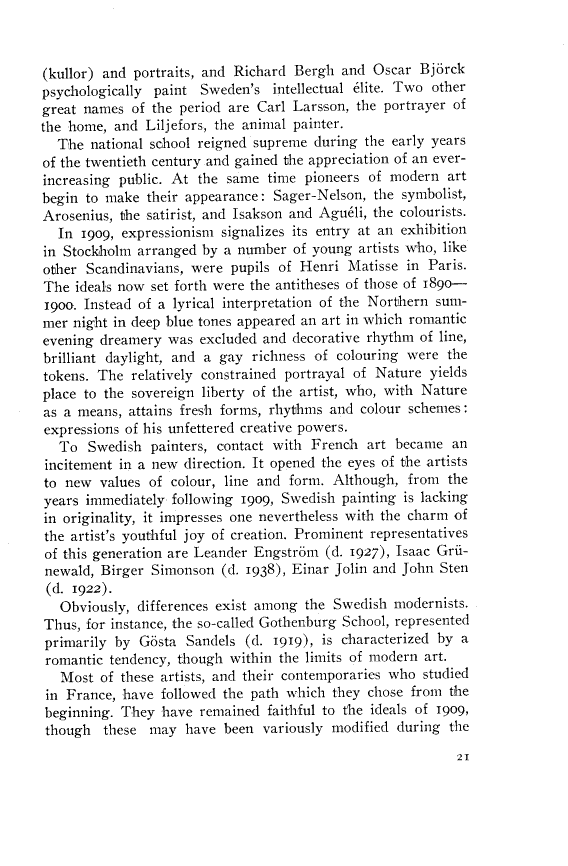
Full resolution (TIFF) - On this page / på denna sida - A short survey of the development of Swedish painting

<< prev. page << föreg. sida << >> nästa sida >> next page >>
Below is the raw OCR text
from the above scanned image.
Do you see an error? Proofread the page now!
Här nedan syns maskintolkade texten från faksimilbilden ovan.
Ser du något fel? Korrekturläs sidan nu!
This page has never been proofread. / Denna sida har aldrig korrekturlästs.
(kullor) and portraits, and Richard Bergh and Oscar Björck
psychologically paint Sweden’s intellectual élite. Two other
great names of the period are Carl Larsson, the portrayer of
the home, and Liljefors, the animal painter.
The national school reigned supreme during the early years
of the twentieth century and gained the appreciation of an
ever-increasing public. At the same time pioneers of modern art
begin to make their appearance : Sager-Nelson, the symbolist,
Arosenius, the satirist, and Isakson and Aguéli, the colourists.
In 1909, expressionism signalizes its entry at an exhibition
in Stockholm arranged by a number of young artists who, like
other Scandinavians, were pupils of Henri Matisse in Paris.
The ideals now set forth were the antitheses of those of 1890—
1900. Instead of a lyrical interpretation of the Northern
summer night in deep blue tones appeared an art in which romantic
evening dreamery was excluded and decorative rhythm of line,
brilliant daylight, and a gay richness of colouring were the
tokens. The relatively constrained portrayal of Nature yields
place to the sovereign liberty of the artist, who, with Nature
as a means, attains fresh forms, rhythms and colour schemes :
expressions of his unfettered creative powers.
To Swedish painters, contact with French art became an
incitement in a new direction. It opened the eyes of the artists
to new values of colour, line and form. Although, from the
years immediately following 1909, Swedish painting is lacking
in originality, it impresses one nevertheless with the charm of
the artist’s youthful joy of creation. Prominent representatives
of this generation are Leander Engström (d. 1927), Isaac
Grünewald, Birger Simonson (d. 1938), Einar Jolin and John Sten
(d. 1922).
Obviously, differences exist among the Swedish modernists.
Thus, for instance, the so-called Gothenburg School, represented
primarily by Gösta Sandels (d. 1919), is characterized by a
romantic tendency, though within the limits of modern art.
Most of these artists, and their contemporaries who studied
in France, have followed the path which they chose from the
beginning. They have remained faithful to the ideals of 1909,
though these may have been variously modified during the
21
<< prev. page << föreg. sida << >> nästa sida >> next page >>